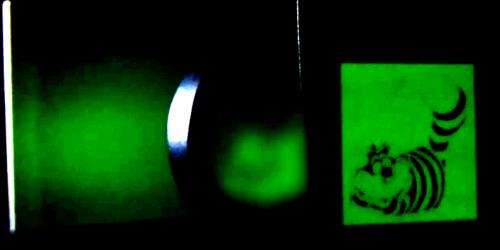Researchers develop an optical system that enhances visualization in opaque environments such as skin

A team of scientists led by researcher Jesus Lancis, at the Institute of New Imaging Technologies in the Universitat Jaume I, in collaboration with lecturer Pedro Andrés, at the Department of Optics in the University of Valencia, has proposed a new mechanism that allows viewing through turbid media. Study results have been published recently and have aroused great interest in the scientific community for their potential applications in biomedicine, specifically to display internal biological tissue layers.
Optical image techniques are quickly becoming essential tools in the biomedical sciences, as they are not invasive; they are quick and inexpensive and pose no health risks because they do not use ionizing radiation. However, one of the biggest challenges they face is to capture sharp images of deep layers of living tissue because of the high diffusion that light suffers when passing through.
Research conducted jointly by the Institute of New Imaging Technologies at the Universitat Jaume I in Castelló and the Department of Optics in the University of Valencia is a significant step in overcoming the fundamental limitations inherent in the propagation of light through turbid media that enables to transmit images to distances clearly superior to the length of termination.
For this purpose, the team of Valencian researchers led by Jesús Lancis used a micromirror array, identical to that used by commercial video projectors, to project a set of microstructured light patterns that overlap sequentially on the sample Then, the total energy transmitted to each one of them via a simple photodetector, which detects the amount of transmitted light, is measured. Finally, a signal processing technique recently introduced, called "compressive sampling", enables them to reconstruct the image.
Pedro Andrés notes that "one of the most surprising aspects of this research is that the result is achieved using a single-pixel detector, i.e., without spatial resolution, when precisely the current trend is to use matrix sensors consisting of tens of megapixels". It is also remarkable to note that the technique may operate through dynamic turbid media.
Most of the diffuser media of interest, such as biological tissue, are dynamic in the sense that the distribution centres continuously change their positions over time. This is generally an added difficulty for transmitting or receiving images. "Our technique, however, requires a calibration of the medium, and its fluctuations during the detection step does not limit the ability of imaging", states Enrique Tajahuerce, co-author of the work.
"Our ultimate goal is to break the barriers that limit the penetration depth of light into the interior of a turbid medium, either a living tissue, or a turbulent atmosphere", adds Lancis. To do this, they need to show that the technique works even when the sample is fully immersed in the tissue, as can be the case of a tumor or other kind of malformation.
This work, carried out completely in the Valencia Community, has been funded with different funds of the Spanish Plan of R&D from the Ministry of Science and Innovation and with financial support from the Valencian Regional Government through the Prometheus programme.
Research has drawn the attention of the editors of the journals of the Optical Society of America (OSA) and the American Association of Physics (APS), who have jointly prepared a story for broadcast media. The article in which the above results have been recently published in the journal Optics Express, which is an open-access journal of the OSA, can be found at "Image transmission through dynamic scattering media by single-pixel photodetection".
More information: Enrique Tajahuerce, Vicente Durán, Pere Clemente, Esther Irles, Fernando Soldevila, Pedro Andrés, and Jesús Lancis. "Image transmission through dynamic scattering media by single-pixel photodetection." Optics Express Vol. 22, No. 14 DOI: 10.1364/OE.22.016945
Journal information: Optics Express
Provided by Asociacion RUVID




















